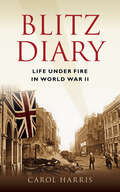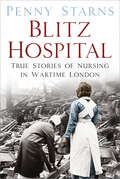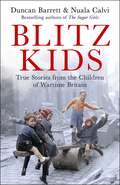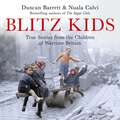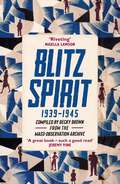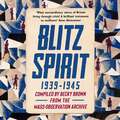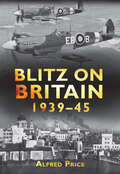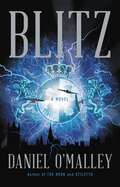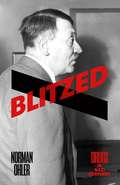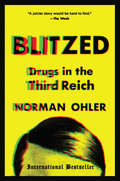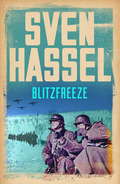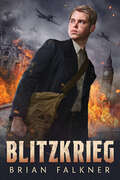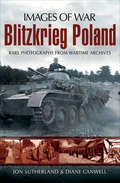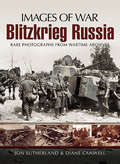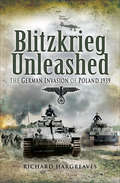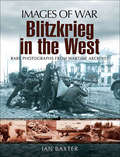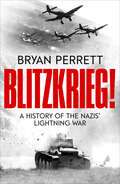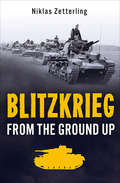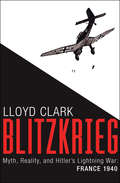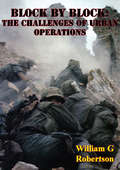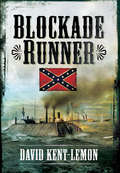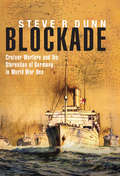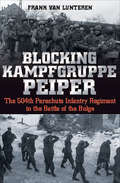- Table View
- List View
Blitz Diary: Life Under Fire in the Second World War
by Mike Brown Carol HarrisDuring the 1930s, war with Germany became increasingly likely. The British Government believed that it would start with massed ranks of enemy planes, dropping bombs and poison gas on civilians in major towns and cities, terrifying them into surrendering. When war broke out, preparations to protect the population were piecemeal and inadequate. As anticipated, people were shocked by the first raids and the response of rescue services was chaotic. But far from breaking morale, the Blitz galvanised public opinion in support of the war. Soon people became hardened by their experiences and attacks from the air became a normal, albeit terrible, part of daily life. Blitz Diary tells the story in a remarkable series of eyewitness accounts from the war’s earliest and darkest days through to the end, when the V-2 rockets brought devastation without warning. Preservation of such first-hand accounts has become increasingly important as the Blitz fades from living memory. This expanded edition includes new chapters and new accounts from key eyewitnesses.
Blitz Hospital: True Stories of Nursing in Wartime London
by Penny StarnsAs the German Luftwaffe subjected Britain’s major cities and ports to unremitting waves of aerial bombardment, doctors, nurses and first aiders constantly risked their lives to give urgent treatment to the severely wounded. Over 80,000 casualties were sustained during this period and city hospitals, especially in London, were working under extreme conditions. The diaries of London nurses reveal that they were confronted by a vast array of appalling injuries on a daily and nightly basis. This book follows the fortunes of three major London hospitals as they struggled to cope with mounting casualties: The Royal London Hospital, St Thomas’s Hospital and Great Ormond Street Hospital. Together, through previously unpublished wartime diaries, letters and reports of medical and nursing staff, they highlight the many human stories of tremendous courage and hope that lived and breathed within the corridors, theatres and wards of London’s hospitals during the Blitz.
Blitz Kids: True Stories from the Children of Wartime Britain for the 80th anniversary of VE day
by Nuala Calvi Duncan BarrettPublished to celebrate the 80th anniversary of VE day'Betty heard the scream of bombs falling and the terrifying thud of explosions. Suddenly, there was a deafening bang, and her mother was thrown across the shelter. For a moment everything was lit up by a blood-red light. Then they were plunged into darkness...'When the Second World War began, there were 10 million children living in Britain. Many were evacuated to the countryside, but others stayed behind and witnessed the Blitz close-up in cities around the UK.Blitz Kids tells the remarkable true stories of children who spent their nights in cold, cramped air-raid shelters, hearing the rumble of planes and the crash of bombs overhead. Many woke up in the morning to find their homes and schools destroyed, their favourite toys buried beneath rubble, their pets lost and, in some cases, their families shattered. Yet amid the turmoil and tears, they found a way to enjoy their childhoods, collecting steaming-hot shrapnel, turning bombed-out houses into adventure playgrounds, and chasing American GIs for chocolate and chewing gum.From headstrong East-Ender Kitty to quick-witted Liverpudlian Christopher - and little Doreen, who survived the devastation of Coventry - Blitz Kids brings together the moving true stories of a remarkable generation now passing into history.
Blitz Kids: True Stories from the Children of Wartime Britain to commemorate the 80th anniversary of VE Day
by Nuala Calvi Duncan BarrettPublished to commemorate the 80th anniversary of VE Day'[The] stories are every bit as dramatic as those from the front lines and Barrett and Calvi have done an incredible job. Their poignant, page-turning book, filled with tears and joy, reminds us innocents always suffer' Daily Express'The 80th anniversary of VE Day takes place on Thursday 8 May and inspirational new book Blitz Kids captures the stories of some of the people who lived through, and still remember, that period' Sunday Express'Betty heard the scream of bombs falling and the terrifying thud of explosions. Suddenly, there was a deafening bang, and her mother was thrown across the shelter. For a moment everything was lit up by a blood-red light. Then they were plunged into darkness...'When the Second World War began, there were 10 million children living in Britain. Many were evacuated to the countryside, but others stayed behind and witnessed the Blitz close-up in cities around the UK.Blitz Kids tells the remarkable true stories of children who spent their nights in cold, cramped air-raid shelters, hearing the rumble of planes and the crash of bombs overhead. Many woke up in the morning to find their homes and schools destroyed, their favourite toys buried beneath rubble, their pets lost and, in some cases, their families shattered. Yet amid the turmoil and tears, they found a way to enjoy their childhoods, collecting steaming-hot shrapnel, turning bombed-out houses into adventure playgrounds, and chasing American GIs for chocolate and chewing gum.From headstrong East-Ender Kitty to quick-witted Liverpudlian Christopher - and little Doreen, who survived the devastation of Coventry - Blitz Kids brings together the moving true stories of a remarkable generation now passing into history.
Blitz Kids: True Stories from the Children of Wartime Britain to commemorate the 80th anniversary of VE Day
by Nuala Calvi Duncan BarrettPublished to commemorate the 80th anniversary of VE Day'Betty heard the scream of bombs falling and the terrifying thud of explosions. Suddenly, there was a deafening bang, and her mother was thrown across the shelter. For a moment everything was lit up by a blood-red light. Then they were plunged into darkness...'When the Second World War began, there were 10 million children living in Britain. Many were evacuated to the countryside, but others stayed behind and witnessed the Blitz close-up in cities around the UK.Blitz Kids tells the remarkable true stories of children who spent their nights in cold, cramped air-raid shelters, hearing the rumble of planes and the crash of bombs overhead. Many woke up in the morning to find their homes and schools destroyed, their favourite toys buried beneath rubble, their pets lost and, in some cases, their families shattered. Yet amid the turmoil and tears, they found a way to enjoy their childhoods, collecting steaming-hot shrapnel, turning bombed-out houses into adventure playgrounds, and chasing American GIs for chocolate and chewing gum.From headstrong East-Ender Kitty to quick-witted Liverpudlian Christopher - and little Doreen, who survived the devastation of Coventry - Blitz Kids brings together the moving true stories of a remarkable generation now passing into history.
Blitz Spirit: Voices of Britain Living Through Crisis, 1939-1945
by Becky Brown'Finally, a book that is proving very therapeutic in these difficult times... Full of doubt, fear, anger and rueful comedy, they give the lie to the idea that the Brits maintained a stiff upper lip, but it's immensely consoling to know that our forebears sometimes thought that they were living through the end times but survived to enjoy better and brighter days.' Jonathan Coe, The Times'With 34 million of us in Tier 3, these Mass Observation diaries have an added fascination: it's impossible to read them without coming across parallels on almost every page, people's characters revealing themselves under wartime restrictions just as they do under Covid ones.' The Times'A great book - such a good read.' Jeremy Vine'Brown's book features an eclectic selection from the wartime years and is full of fascinating and sometimes surprising insights.' Mail on Sunday'Moving and unexpectedly funny, it's these words that may offer comfort.' Woman's Weekly'What extraordinary voices of Britain living through crisis! A brilliant testament to resilience.' Anne Glenconner'A stirring and evocative account of life on the home front. Full of surprises that bring a fascinating perspective on the blitz spirit.' - Deborah Cadbury, author of Chocolate Wars and Princes at War***Throughout the Second World War hundreds of people kept diaries of their private daily lives as part of a groundbreaking national experiment. They were warehousemen and WRENs, soldiers and farmhands, housewives and journalists, united only by a desire to record the history they were living through.For decades their words have been held in the Mass-Observation Archive, a time capsule of ordinary voices that might otherwise have been forgotten. These voices tell the human story behind the iconic events of those six years, of the individuals grappling with a world turned upside down. From panic-buying and competitively digging for victory to extraordinary acts of bravery, Blitz Spirit is a remarkable collection of real wartime experiences that represent the best and worst of human nature in the face of adversity. Resonant, darkly funny and deeply moving, this new collection will reveal what it was like to live through a crisis of unprecedented proportions. A cacophony of hope, cynicism and resilience, Blitz Spirit celebrates ordinary lives - however small - and shines a light on the people we were, and the people we are now.
Blitz Spirit: Voices of Britain Living Through Crisis, 1939-1945
by Becky BrownFor today's reader, who is living through our biggest social dislocation since the Second World War and witnessing a crisis of unprecedented proportions, Blitz Spirit is a book written to gently invite comparison and provoke questions about our place in history. Becky Brown has selected extracts from the Mass Observation Archives to anthologise the voices of everyday people as they deal individually and collectively with the crisis of the Second World War. The diarists themselves have been selected from every level of society - from warehousemen to widows, soldiers to farmhands, WRENs to architects.The extracts have been chosen to both uplift and to ground; to remind readers that nothing is new, that everything can be weathered and perhaps even made better. After all, World War II saw the birth of the NHS.(P) 2020 Hodder & Stoughton Ltd
Blitz on Britain 1939-45
by Alfred PriceDuring the latter half of the 1930s, the fear of a possible aerial knock-out on Great Britain became a dominating factor in the formulation of national policy. This text examines how justified these pre-war fears were in light of the Luftwaffe's capabilities in 1939 and describes the bombing attacks on Britain during the years that followed, together with the operations of the defences to parry them. From the start, the air defences proved able to take a heavy toll on the bombers attacking Britain by day. By night it was a different matter. Initially, the fighter and gun defences were lucky if between them they were able to knock out one or two bombers out of three or four hundred involved in a night attack. From this poor beginning the defences improved out of all recognition and when the Germans launched a series of attacks on London early in 1944, it cost them one bomber and four trained crewmen for every five British civilians killed. Blitz on Britain makes compelling reading for anyone interested in the Luftwaffe's wartime raids on Britain, and how the air defences ultimately succeeded in defeating this long running aerial onslaught.
Blitz: A Novel (The Rook Files #3)
by Daniel O'MalleyIn this historical fantasy, a new recruit to the most powerful supernatural intelligence agency on Earth is accused of going rogue—and must go on the run to clear her name.September, 1940. Three women of the Checquy, the secret organization tasked with protecting Britain from supernatural threats, stand in the sky above London and see German aircraft approach. Forbidden by law to interfere, all they can do is watch as their city is bombed. Until Pamela, the most sensible of them, breaks all the rules and brings down a Nazi bomber with her bare hands. The three resolve to tell no one about it, but they soon learn that a crew member is missing from the downed bomber. Charred corpses are discovered in nearby houses and it becomes apparent that the women have unwittingly unleashed a monster. Through a city torn by the Blitz, the friends must hunt the enemy before he kills again. Their task will take them from the tunnels of the Underground to the halls of power, where they will discover the secrets that a secret organization must keep even from itself. Today. Lynette Binns, a librarian with a husband and child, is a late recruit to the Checquy, having discovered only as an adult her ability to electrify everyday objects with her touch. After completing her training, she is assigned to examine a string of brutal murders and quickly realizes that all bear the unmistakable hallmark of her own unique power. Unable to provide an alibi and determined to prove her innocence, she flees, venturing into the London underworld to find answers. But now she is prey, being tracked by her own frighteningly capable comrades. As Lyn fights off powered thugs and her own vengeful colleagues, she will find that the solution to the murders and to the mystery of her own past lies in the events of World War II, and the covert actions of three young women during the Blitz.
Blitzed: Drugs In Nazi Germany
by Shaun Whiteside Norman OhlerThe sensational German bestseller on the overwhelming role of drug-taking in the Third Reich, from Hitler to housewives. The Nazis presented themselves as warriors against moral degeneracy. Yet, as Norman Ohler's gripping bestseller reveals, the entire Third Reich was permeated with drugs: cocaine, heroin, morphine and, most of all, methamphetamines, or crystal meth, used by everyone from factory workers to housewives, and crucial to troops' resilience - even partly explaining German victory in 1940. The promiscuous use of drugs at the very highest levels also impaired and confused decision-making, with Hitler and his entourage taking refuge in potentially lethal cocktails of stimulants administered by the physician Dr Morell as the war turned against Germany. While drugs cannot on their own explain the events of the Second World War or its outcome, Ohler shows, they change our understanding of it. Blitzed forms a crucial missing piece of the story.
Blitzed: Drugs in the Third Reich
by Norman OhlerA New York Times bestseller, Norman Ohler's Blitzed is a "fascinating, engrossing, often dark history of drug use in the Third Reich” (Washington Post). The Nazi regime preached an ideology of physical, mental, and moral purity. Yet as Norman Ohler reveals in this gripping history, the Third Reich was saturated with drugs: cocaine, opiates, and, most of all, methamphetamines, which were consumed by everyone from factory workers to housewives to German soldiers. In fact, troops were encouraged, and in some cases ordered, to take rations of a form of crystal meth—the elevated energy and feelings of invincibility associated with the high even help to account for the breakneck invasion that sealed the fall of France in 1940, as well as other German military victories. Hitler himself became increasingly dependent on injections of a cocktail of drugs—ultimately including Eukodal, a cousin of heroin—administered by his personal doctor. Thoroughly researched and rivetingly readable, Blitzed throws light on a history that, until now, has remained in the shadows. “Delightfully nuts.”—The New Yorker
Blitzfreeze (Sven Hassel War Classics)
by Sven HasselA shocking insight into the realities of war, the conditions endured by ordinary soldiers and their unwavering solidarity.It was supposed to be Hitler's glorious conquest of Russia...The 27th Penal Regiment has been ordered to invade the Soviet Union. They are half-starved and ill-equipped. To reach Moscow they must defeat the fearsome Red Army.But instead, they find themselves at the mercy of an even deadlier enemy: the killer cold of the Russian winter. As they advance across the icy wastes, they think only of survival.
Blitzfreeze (Sven Hassel War Classics)
by Sven HasselA shocking insight into the realities of war, the conditions endured by ordinary soldiers and their unwavering solidarity.It was supposed to be Hitler's glorious conquest of Russia...The 27th Penal Regiment has been ordered to invade the Soviet Union. They are half-starved and ill-equipped. To reach Moscow they must defeat the fearsome Red Army.But instead, they find themselves at the mercy of an even deadlier enemy: the killer cold of the Russian winter. As they advance across the icy wastes, they think only of survival.
Blitzkrieg
by Brian FalknerAn intriguing and thought-provoking WWII novel inspired by real events from the international award-winning author Brian Falkner!In Nazi-ruled Germany, Joe St. George is forced to watch as the country is divided around him by fear and hate. Joe thinks he and his family are safe, but when his father disappears one night, everything changes. Suddenly Joe and his mother are suspects of the state, but for what, Joe has no idea. They plan their escape from Germany, even though it means leaving Joe’s father behind. However, Joe and his mom are separated before they make it out, and he is forced to go on without her.Eventually Joe in arrives London but quickly realizes he’s not free of the Nazis. Since Joe’s escape, Hitler has been marching west, and London is under constant attack from the skies. Desperate to find his parents, Joe begins to dig into what happened back home. But the truth is a lot more complicated and dangerous than Joe ever imagined, and soon he is recruited by MI5 and given a deadly mission that will put him in the very center of Hitler’s ruthless reign. From vital convoys across the frozen North Atlantic, to the terror of the Blitz, to the shadowy world of the French Resistance, just how far will Joe have to go to save his family ... and himself?
Blitzkrieg Poland: Rare Photographs from Wartime Archives (Images of War)
by Diane Canwell Jon Sutherland"These photographs are taken from three unpublished albums featuring the German invasion of Poland in 1939. One set was taken by an SS officer, another by a regular officer and a third by a soldier attached to a medical unit. Included are German units on the move, tanks, artillery and aircraft.There are several shots of recently knocked out Polish vehicles, captured Polish troops and civilians. The shots reflect the rapid pace of the German advance through Poland, some of the cities, towns and villages show signs of heavy fighting, whilst others appear to be untouched. One of the sets show a German unit mounted in fast open cars, heavily armed, speeding through the Polish countryside. Another features armored vehicles and engineers, while another shows the ambulance teams moving up to the front through devastation and chaos.There are also numerous opportunities throughout the book to see uniforms in their various guises and how they were actually worn in practice. There are shots of earlier German armor, antique Polish armor, and photographs of German troops at rest and preparing to move forward again."
Blitzkrieg Russia: Rare Photographs from Wartime Archives (Images of War)
by Diane Canwell Jon SutherlandThe photographs are taken from five unpublished albums focussing on the German invasion of Russia in 1941 Operation Barbarossa. Two of the albums contain shots taken by German infantrymen and include shots of combat, vehicles, knocked-out tanks and prisoners of war. Two of the other albums feature flak and artillery units in the invasion. These include shots of artillery and flak units in action, destroyed Russian aircraft, vehicles and armor as well as Russian prisoners. The final album contains shots taken by a tank destroyer unit. In this set, there are shots of knocked out Russian armor (and abandoned armor), artillery and assault guns in action and a fascinating glimpse into the transition into the first winter. There are many exceptional photographs including rubber boats carrying troops across a river, knocked out monstrous Russian tanks, engineers at work and a range of more casual poses. There are also some interesting studies of uniforms and equipment, abandoned vehicles, vehicles being salvaged and maintained and a host of other subjects.Some are focussed on the early war months with Russia, so there are huge columns of captured Russian prisoners, fraternization with the local peasants and a glimpse of the vast distances involved in the advances made by the Germans in the early months of the conflict.
Blitzkrieg Unleashed: The German Invasion of Poland 1939 (Stackpole Military History Ser.)
by Richard HargreavesAt dawn on Friday 1 September 1939 the Germans launched their land, sea and air assault on Poland. The World became aware of the awesome power of Hitler's Third Reich and the limitless and ruthless nature of his ambition.The Blitzkrieg (Lightning War) attack, spearheaded by Panzers, took the German forces to the gates of Warsaw in a week. The vital port of Danzig fell, crushed by naval and air bombardment and land assaults. The Polish Air Force, out-numbered and out-gunned, were driven from the skies. In a month Warsaw fell amid great bloodshed and in six weeks the Poles were defeated.The speed of the German conquest was matched by its brutality. Lives and property meant little to the invaders and civilians and POWs were summarily executed. Jews received particular attention and these atrocities were not just perpetrated by the SS but soldiers of the Wehrmacht.Blitzkrieg Unleashed is told in the words of those who conquered Poland, thanks to the author's research into letters, diaries, unpublished accounts, official documents and histories and newspapers.
Blitzkrieg in the West: Rare Photographs from Wartime Archives (Images of War)
by Ian Baxter"This superbly illustrated book captures the dramatic action of May and June 1940. The speed and ferocity of the German onslaught took the Allies by surprise as Hitlers land and air forces annihilated the inferior opposition. After 9 months stalemate the collapse was cataclysmic and Holland and Belgium quickly fell leaving the British and French forces outflanked and outfought. Panic set in and huge numbers of civilian refugees clogged the roads making the Allies withdrawal even more precarious. The miracle of Dunkirk saved vast numbers of British and French forces but could not prevent the surrender of France, leaving Britain to fight on virtually alone. The splendid photographs in this Images of War series book tell the story of this extraordinary period of history. They include previously unseen images of Rommels Ghost Division."
Blitzkrieg!: A History of the Nazis' Lightning War
by Bryan PerrettThe Lightning Warfare that changed history foreverIf Hitler had failed in his invasion of Western Europe in 1940 he could well have been assassinated by a group of his senior officers. But he decisively defeated the combined efforts of the British, French, Dutch and Belgian armies in a matter of days. The technique employed was known as Blitzkrieg or Lightning War. Nothing would be the same again.Although strands were clearly apparent by 1918, it was perfected through the interwar years before being deployed with terrifying effect by the Nazis at the outbreak of the Second World War. Eventually, other combatants would employ similar methods and the tide would turn.As well as discussing the developing nature of tactics, fighting vehicles and aircraft from 1918 onwards, the author examines the potent workings of Blitzkrieg in-depth, describing not only its obvious triumphs but also its fatal flaws.This is explosive military history from bestseller Bryan Perrett, perfect for readers of Antony Beevor or Damien Lewis.
Blitzkrieg: From the Ground Up
by Niklas ZetterlingFrom the author of Bismarck: &“A work of simply outstanding scholarship . . . unreservedly recommended for . . . World War II Military History collections&” (Midwest Book Review). The successes of the German Blitzkrieg in 1939-41 were as surprising as they were swift. Allied decision-makers wanted to discover the Germans&’ secrets, even though only partial, incomplete information was available to them. The false conclusions drawn became myths about the Blitzkrieg that have lingered for decades. It has been argued that rather than creating a new way of war based on new technology, the Germans fitted the new weapons into their existing ideas on warfare. The conduct of German soldiers, particularly the lower-ranking men, on the battlefield was at the core of the concept, and German victories rested upon the quality, flexibility, and mobility of the small combat units. This book focuses on the experiences of the enlisted men and junior officers in the Blitzkrieg operations in Poland, Norway, Western Europe, and Russia. Using accounts previously unpublished in English, military historian Niklas Zetterling &“not only shows you the big picture, economically, strategically, but also takes you right into the Panzers,&” showing how a company commander led his tanks, how a crew worked together inside a tank, and the role of the repair services. &“For those of us who are interested in the tactics and strategy of the early war years, it is a book you won&’t want to miss&” (A Wargamers Needful Things). &“In support of his convincing argument the author uses several accounts of German actions seen through the eyes of the soldiers and junior officers who had to put theory into practice on the battlefield. 4.5 stars.&” —Army Rumour Service
Blitzkrieg: Myth, Reality, and Hitler’s Lightning War: France 1940
by Lloyd ClarkA “masterly account” of the juggernaut offensive that conquered France—but also marked the beginning of the end for Nazi Germany in World War II (Kirkus Reviews). In the spring of 1940, the German forces launched an attack on France that combined superb intelligence, cutting edge strategy, and new technology—the blitzkrieg, or “lightning war.” In just six weeks, it would achieve what their fathers had failed to do in all four years of the First World War. It was a stunning victory. But here, leading British military historian and academic Lloyd Clark argues that much of our understanding of this victory is based on myth. Far from being a foregone conclusion, Hitler’s plan could easily have failed had the Allies been even slightly less inept or the Germans less fortunate. The Germans recognized that success depended not only on surprise, but also avoiding a protracted struggle for which they were not prepared—making defeat a very real possibility. Their surprise victory proved the apex of their achievement; far from being undefeatable, Clark argues, the Battle of France revealed Germany and its armed forces to be highly vulnerable. And Hitler dismissed this fact as he planned his next move—and greatest blunder: the invasion of the Soviet Union. In this eye-opening reassessment, complete with maps and illustrations, Clark “presents a well-balanced narrative that highlights the knife-edge victory of the German forces” and reveals how very close the Nazi war machine came to catastrophe in the early days of World War II (New York Journal of Books).
Block By Block: The Challenges Of Urban Operations [Illustrated Edition]
by William G. RobertsonIncludes more than 20 maps, diagrams and tables.History instructs that for a variety of reasons, cities have always been targets for attack by adversaries. From the earliest of times, attackers came bearing weapons ranging from knives, arrows, and spears, while in modern times, they have brought weaponry the Industrial Revolution made available: cannon, rocket artillery, and ultimately bombs and rockets delivered from aerial platforms and even thermonuclear warheads, not to mention the potential for chemical and biological payloads. In turn, cities have responded to most of these threats. Early on, for example, they thickened city walls and erected other barriers to entry. But attackers seeking to subdue the cities simply countered with new and better weapons. So the game of measures and countermeasures-the adult, and much more deadly, version of the familiar children's game of rock, scissors, paper-has continued apace for centuries.The expert authors of this excellent study focus on the following Urban Operations1) Through the ages - Pre Second World War Urban Combat2) Bloody Stalingrad3) The demolition of Aachen4) Battle of Manila5) The Siege of Hue6) Battle for Grozny7) Fight for Beirut8) Siege of Sarajevo9) The capture of Kabul10) Lightning strike at Panama City11) Urban Terrorism in Argentina12) The US Military in the Hurricane Katarina rescue effort13) The Future of Urban Combat
Blockade Runner
by David Kent-LemonIt is 1861. Tom Wells is in pursuit of a girl from North Carolina. He accepts an offer from his employer to leave the quiet obscurity of his job as an office boy in a London shipping firm to cross the Atlantic to Nassau in the Bahamas. Now he must face the hazards of the Union blockade of the Confederate ports in the American Civil War. Toms bravado may help him with the dangers of running the blockade, but how will he cope with the conflicting issues of love, loyalty and morality as he becomes entangled with a lady of easy virtue in Nassau?Toms adventures take him through the perilous triangle between Nassau, Charleston and Wilmington NC, where he must smuggle arms and munitions through a gauntlet of Union warships to the Southern ports, bringing cotton and tobacco back to Nassau. David Kent-Lemon presents us here with a fast paced and dynamic narrative, exploring a fascinating, dramatic and less well-known corner of that extraordinary conflict the American Civil War. The characters are finely drawn, with the balance between deceit and morality offset by courage and humor. The realism and historical accuracy of the background complete the picture.As the Civil War reaches its climax, so does the drama in Tom's life, heightened by the historical events within which he is embroiled.
Blockade: Cruiser Warfare and the Starvation of Germany in World War One
by Steve R DunnThis WWI naval history vividly tells the story of the Royal Navy&’s Northern Blockade and the battles at sea that brought Germany to its knees. At the outbreak of World War I, Britain established a naval blockade that greatly diminished Germany&’s access to trade and vital resources. The Northern Blockade brought the German economy to its knees and greatly diminished home front morale. Patrolling the inhospitable waters between Iceland and Scotland, the 10th Cruiser Squadron played a vital role in winning the war on the Western Front. At the same time, the Royal Navy successfully countered Germany&’s attacks on British commerce, preventing much suffering in Britain. Drawing on numerous first-hand accounts, Historian Steve Dunn vividly chronicles this long-running battle at sea. Beginning with the blockade&’s initial formation, he recounts the changes in strategy on both sides, including the use of converted liners and armed merchant vessels as warships. He also vividly describes the final destruction of German surface vessel commerce warfare, culminating in the hard-fought battle between the raider SMS Leopard and two British warships.
Blocking Kampfgruppe Peiper: The 504th Parachute Infantry Regiment in the Battle of the Bulge
by Frank van LunterenThe account of these elite paratroopers&’ encounter with the Germans is &“a story of raw courage in the face of seemingly impossible odds . . . a great read&” (World War II). In December 1944, an enormous German army group crashed through the thin American line in the Ardennes forest. Caught by surprise, the Allies were initially only able to throw two divisions of paratroopers to buttress the collapse—the 82nd Airborne, which was rushed to the area of St. Vith, and the 101st, which was trucked to Bastogne. After their successful campaign in Holland, Col. Reuben Tucker&’s elite 504th Parachute Infantry Regiment was resting and refitting in France when news came of the German breakthrough. Most dangerous to the Allies was the German spearhead of the 1st SS Panzer Division led by Jochen Peiper, which aimed to sever the Allied front. The 504th was committed to block the SS advance, and within forty-eight hours of their arrival, Col. Tucker&’s paratroopers were attacking the SS-Panzergrenadiers of Peiper&’s battlegroup, eventually forcing them to withdraw. More ferocious fighting ensued as follow-up German units forced a US retreat from St. Vith. In adverse weather conditions against the German 9th SS Panzer and 3rd Fallschirmjäger Divisions, the 504th lived up to its regimental motto: Strike and Hold. Although some rifle companies were whittled down to less than fifty paratroopers, the Americans doggedly fought on until victory was achieved. This work provides a fascinating, up-close view of the 504th PIR during the Battle of the Bulge, as well as its gallant sacrifice. Using never-before-published diaries, letters, battle reports, and interviews with over a hundred veterans, a comprehensive account is painted of a triumphant US regiment in one of the fiercest-fought campaigns in the history of the US Army.
